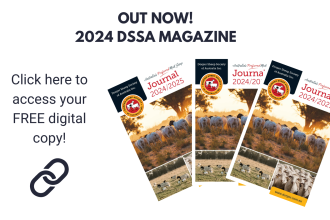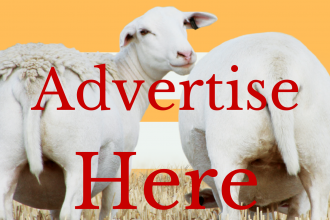GENERAL
The DSSA has adopted the Breed Standard of Excellence as set out in the, Dorper Sheep Breeders’ Society of South Africa publication ‘Dorpers into the New Century’ written by Dolf Lategan. This standard was developed based on extensive research as the breed was refined over more than 70 years in South Africa and has travelled with the Dorper Breeds across the world where it is adopted by a number of countries that produce quality Dorper and White Dorper sheep. The ideal Dorper Sheep is an animal, which can maintain itself, produce meat and reproduce under sub-optimal conditions. You can order a hard copy of the Dorper’s Into The New Century manual from the DSSA office for $55.00 including postage.
The society will approve inspectors from time to time to class Dorper sheep and enter the classing details on the registration record of the inspected animals. At the time of inspection the animals will be tagged with an approved tag by the inspector and the number recorded and forwarded to the Society. The inspection is a quality assessment on a voluntary basis.
Definition: To distinguish the degree of excellence with a description and score by points on visual appearance and performance. These values must be a true reflection of the animal.
The following score system is used:
- Very good 5 points
- Above average 4 points
- Average 3 points
- Poor or below average 2 points
- Very poor with cull points 1 point
The following comprises the Breed Standard.
1. Conformation
Head: Strong and long with eyes widely spaced and protectively placed. Strong nose, strong well shaped mouth with well-fitted deep jaws is the ideal. To qualify for T5, stud and commercial the upper part of the inside on the cutting teeth must be in contact with the upper gum. The lower jaw may be 2mm shorter on adult animals and 3mm shorter on lambs. When an animal is shedding the front teeth, the adjacent teeth may be used for evaluation of the fit. The forehead must not be dished. The size of the ears must be in relation to the head. A developed horn base or small horns are the ideal. Discriminate according to size against heavy horns
Forequarter and neck: The neck should be of medium length, well fleshed, broad and well coupled to the forequarter. Shoulders should be firm, broad and strong. A moderate protrusion of the brisket beyond the shoulders, moderate width and good depth are the ideal. Forelegs must be strong, straight and well placed with strong pasterns and hoofs not too widely split. Weak pasterns and X-legs must be discriminated against according to degree. Shoulders, which appear loose, brisket that slants up too sharply with no projection beyond the shoulders, crooked legs and weak walking ability, are faulty.
Barrel: The ideal is a long, deep, wide body, ribs well sprung, loin broad and full. The sheep must have a long, straight back and not have a Devil’s grip. A slight dip behind the shoulders is permissible.
Hindquarter: A long and wide rump is the ideal. The inner and outer twist to be well-fleshed and deep in adult animals. The hind legs must be strong and well placed with sturdy feet and strong pasterns. Weak, skew pasterns and sickle hocks must be discriminated against according to degree. The hocks must be strong without a tendency to turn in or out. Bandy- or perpendicular hocks are faulty.
Udder and sex organs: Well-developed udder and reproductive organs are essential in the ewe. The scrotum of the ram should not be too long and the testicles should be of equal size and not too small. Any abnormalities in the testicles are cull faults.
• Minimum testicle circumference size in a sitting position:
• 10 months of age 30cm
• 2 tooth 32cm
• 4 tooth 33cm
• 6 tooth and older 34cm
• A split of 1,5cm deep allowed on scrotum of ram, measured from the deepest point to bottom of testicles.
• Any projection of a prolap on the anus or vagina is faulty
General appearance: The sheep must be symmetrical and the body parts balanced in proportion to each other. A calm temperament with a vigorous appearance is the ideal.
2. Size or growth rate
A sheep with good size and weight for its age is the ideal. Discriminate against extremely large or extremely small animals, under the same environmental conditions.
3. Distribution of fat
Too much localisation of fat on any part of the body (see circles) is undesirable. An even distribution of a thin layer of fat over the carcass and between the muscle fibres is the ideal. The sheep must be firm and muscular when handled.
4. Colour pattern
Dorpers: A white sheep with a black head and neck is the ideal. A limited number of spots are allowed on the body and legs. Totally white sheep or sheep that are predominantly black are faulty.
Brown or white hair around the eyes must be discriminated against according to degree. Pink teats, pink under the tail and white hooves are faulty. Brown on the face is undesirable.
White Dorpers: A white sheep, fully pigmented on the eyelids, under the tail and on the teats is the ideal. A limited number of spots are allowed on the ears and underline.
5. Cover or Fleece
Definition: H5 A short, loose, light mixture of hair and wool with a natural clean kemp underline. The head should be covered in short clean kemp.
Definition: H4 A short, loose, light covering of hair and wool with wool predominating on forequarter and with a natural clean underline. Wool is allowed up to the crown of the head.
Definition: H3 A short, loose covering of predominantly wool or softfine hair with perceptible kemp on the outer thigh. A soft light mane or apron is allowed. Wool is allowed forward of the crown on the head.
Definition: H2 a) Almost exclusively coarse hair. b) Almost exclusively wool and very dense.
Definition: H1 a) Exclusively coarse hair. b) Exclusively wool (long and dense). c) A coarse hairy mane.
6. Type
Type is determined by the degree the sheep conforms to the Breed Standards. The general impression must be of good balance, muscling and a vigorous appearance. Masculinity in the ram and femininity in the ewe is important. Note: Any tendency to a cull fault cannot be a Type 5.





